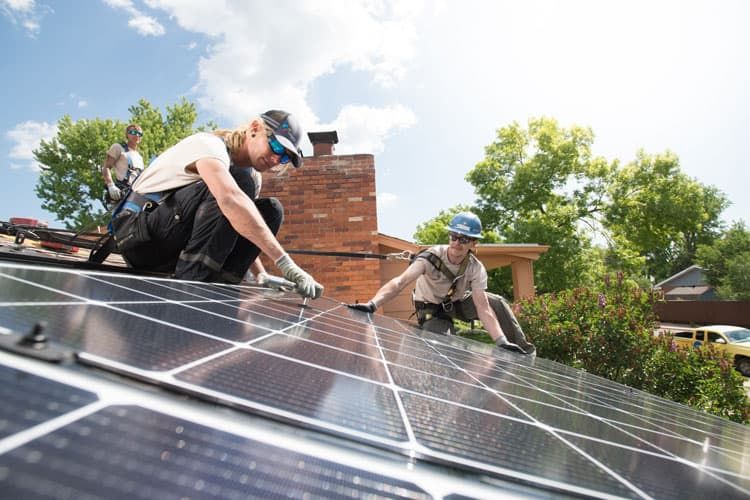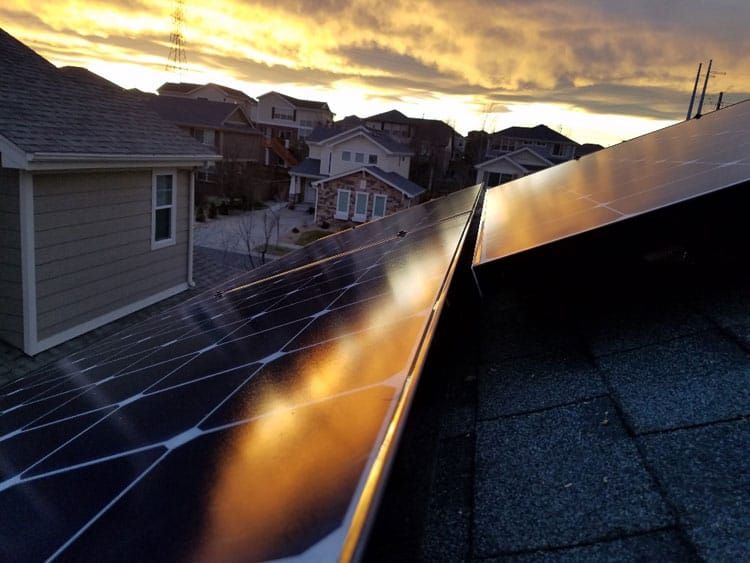Energy subsidies to phase out

Renewable energy companies in Colorado are preparing themselves for the gradual phase-out of federal renewable energy tax credits beginning at the end of 2019.
Currently, home owners receive a 30 percent tax credit if they install fuel cells, small wind turbines, geothermal heat pumps or solar energy systems in their homes, but those credits expire in 2021, after a gradual step down of incentives. On Dec. 31, 2019, the credit drops to 26 percent, and on Dec. 31, 2020, it drops to 22 percent for systems installed before Jan. 1, 2022.
“The good news is the 30 percent is not going away,” said Blake Jones, co-founder of Namasté Solar in Boulder. “It is stepping down to 26 percent. I really like the step-down plan that’s currently in place. In the past, the tax code always would be about to expire and legislators would extend it. The last time it was extended it put in a step-down plan.”
SPONSORED CONTENT
People Powered: Preparing Longmont Businesses for Economic Success
Longmont Chamber and FNBO present People Powered on April 24, 2024, aiming to inform business owners about workforce development, housing, and transportation issues.
Jones believes this type of plan is better for the industry overall. It steps down two times before the incentive goes away completely, giving home owners and businesses a couple of more years to implement a renewable energy power system.
“The step down is significant, but it’s not such a big cliff to fall off,” he said. “On the one hand, it will make solar projects more expensive than they otherwise would be with a 30 percent tax credit; on the other hand, will it hurt? Yes, it will hurt but there will still be a significant market even at the 26 percent tax credit level.”
He believes that even after incentives go away, the market for solar will continue to grow, if at a slower pace than previous years.

Namasté Solar has been messaging customers to let them know the 30 percent incentive will disappear at the end of 2019, and if they want to get a residential system installed they should do it before the end of the year.
On the commercial side, the credits are stepping down as well, but as long as a project starts before the end of 2019, property owners can lock in that 30 percent rate as long as the project is completed within two years, he added.
Namasté installs solar systems in both homes and commercial buildings. He said that his company will prioritize residential installations through the end of this year to make sure that everyone who wants the 30 percent credit can take it.
Solar has become very competitive with fossil fuels, with costs dropping up to 80 percent in the past 15 years. Like other technology-based industries, once it taps into mass production volumes and economies of scale, and critical mass is achieved, the costs come down, Jones said.
He said he would like to see a phase out of incentives for nuclear and fossil fuel-powered energy systems to make it a more level playing field for renewable energy sources.
“Why wean us off subsidies when conventional industries have not?” he asked.
There is still a possibility that Congress will extend the renewable energy tax credit before the step down starts at the end of the year.
“It’s very difficult to predict what will come out of Congress or what bill the president may or may not sign,” Jones said.
“Customers today install solar systems for a variety of reasons, not just cost,” said Mark Stutz, spokesman for Xcel Energy-Colorado, which serves 1.5 million electric customers in the state. “We believe it’s largely about the desire to be green. Incentives have been decreasing for some time as the costs of solar systems have decreased as well.”
Xcel Energy has about 45,000 residential on-site solar installations on its system, primarily through the company’s Solar*Rewards program in Colorado. Xcel traditionally has provided one incentive payment for the Renewable Energy Credits through its Solar*Rewards program, but Stutz said those are down to about half a cent per kilowatt-hour, which for a typical customer would be around $30 per month. He said that systems are being installed currently that don’t go through that program but do the net-metering option.
“There still is value in RECs, however, for individuals and businesses that want to make FTC-approved claims about using a percentage of renewable energy,” he said.
The average size of a system installed today is about 5.5 to 6.0 kilowatts and the average cost is between $15,000 and $20,000.
“On average, we’ve seen fairly steady growth over the past decade, about 5 percent a year, and more recently up to 5,000 installations a year and around 30 MW of generation a year,” he added.
Mike Kruger, president and CEO of the Colorado Solar and Storage Association, said that solar has definitely gone mainstream, meaning that those who wanted to install renewable energy at their homes for environmental reasons have probably already done it.
“We are at the tipping point where it becomes something everybody does. We are starting to see clustering of that,” he said.

While companies like Xcel and Platte River Power Authority are moving forward with investments in renewables and solar, some utilities in the state aren’t there yet, he said.
Kruger said that people should take advantage of the tax credits while they are around but return on investment really depends on how the home’s roof is situated. If it has a south-facing roof, a home owner can get paid back quickly. If the roof is flat, it might take five to seven years to recoup upfront costs.
The industrial market is an underserved sector of the solar industry because the economics don’t work out, Kruger said. Businesses are charged based on capacity size. Even if they only use their maximum capacity for an hour a day, they are charged at the peak level and solar incentives aren’t able to offset that, he said.
Energy storage is a huge factor in making renewable energy generation even more efficient. Kruger said that his industry would like to see federal incentives for investing in storage for a residential solar or wind installation.
Storage is about five to seven years behind solar in price and policy, he said. The year 2025 is the best estimate for when storage costs will drop enough so that investment tax credits are no longer needed to make it cost competitive.
Storage units are usually deployed in areas where it makes more economic sense, Kruger said, like Hawaii where energy costs are 30 cents per kilowatt-hour. In Xcel’s territory, energy costs are about 12 cents per kWh.
And while the current federal tax credit is for all renewables, solar gets the lion’s share, about 97 percent of the credits out there. Wind does get a production tax credit.
Colorado ranked sixth in the nation for adopting clean energy technologies and supporting the groups that participate in the cleantech industry, according to the Colorado Cleantech Industries Association. In 2016, the most recent data available, the state employed 26,270 direct employees in cleantech industries, pumping $4.6 billion into the Colorado economy.
Renewable energy companies in Colorado are preparing themselves for the gradual phase-out of federal renewable energy tax credits beginning at the end of 2019.
Currently, home owners receive a 30 percent tax credit if they install fuel cells, small wind turbines, geothermal heat pumps or solar energy systems in their homes, but those credits expire in 2021, after a gradual step down of incentives. On Dec. 31, 2019, the credit drops to 26 percent, and on Dec. 31, 2020, it drops to 22 percent for systems installed before Jan. 1, 2022.
“The good news is…
THIS ARTICLE IS FOR SUBSCRIBERS ONLY
Continue reading for less than $3 per week!
Get a month of award-winning local business news, trends and insights
Access award-winning content today!

